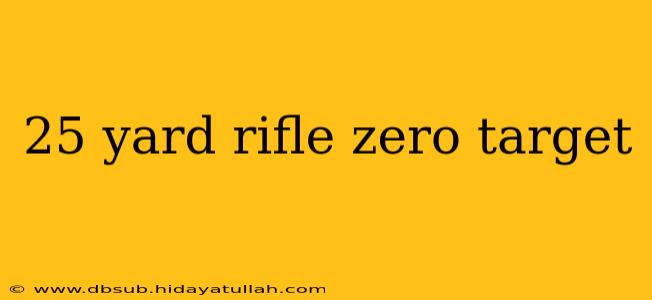Setting your rifle zero at 25 yards is a crucial first step for any shooter, whether you're a seasoned marksman or just starting out. This distance provides a solid foundation for longer-range accuracy, allowing you to diagnose issues with your sight alignment, hold, and trigger control before moving to more challenging distances. This guide will walk you through the process, providing tips and tricks to ensure you achieve a consistent and accurate zero.
Understanding the Importance of a 25-Yard Zero
Before diving into the practical steps, let's understand why 25 yards is the preferred starting point for zeroing your rifle. Several factors contribute to its effectiveness:
- Reduced Environmental Impact: At 25 yards, wind and other environmental factors have a less significant impact on your bullet's trajectory compared to longer ranges. This allows for a more precise zeroing process, minimizing variables.
- Easier Sight Adjustments: Smaller adjustments to your sights are needed at this shorter range, making the process simpler and less prone to error.
- Improved Accuracy Assessment: You can more easily identify and correct flaws in your shooting technique, such as poor trigger control or improper sight alignment. Small errors are magnified at longer ranges, so starting at 25 yards gives you a chance to iron out these kinks.
- Foundation for Longer Ranges: A well-established 25-yard zero serves as an excellent base for moving to longer ranges. Once you're confident at 25 yards, you can progressively move to 50, 100, and beyond, adjusting your zero as needed.
Essential Equipment for Your 25 Yard Rifle Zero
To successfully zero your rifle at 25 yards, you'll need the following equipment:
- Your Rifle: Ensure it's properly cleaned and maintained.
- Ammunition: Use the same type and brand of ammunition you intend to use in the field or competition. Consistency is key.
- Target: A standard 25-yard rifle target (preferably with clear aiming points) is ideal. You can find printable targets online.
- Shooting Rest (Optional): While some prefer to freehand at this distance, a shooting rest can help improve consistency, especially for beginners.
- Tools for Sight Adjustment: This will vary depending on the type of sights you have (iron sights, scopes, etc.). Familiarize yourself with your rifle's sight adjustment mechanism before starting.
- Hearing and Eye Protection: Always prioritize safety.
Step-by-Step Guide to Zeroing Your Rifle at 25 Yards
-
Prepare Your Shooting Area: Ensure you have a safe and stable shooting position. Make sure your background is clear and safe.
-
Set Up Your Target: Place your target at exactly 25 yards. Use a rangefinder if possible for accurate measurement.
-
Find Your Natural Point of Aim: Without adjusting your sights, fire several shots (3-5) and observe where your shots are impacting the target. This helps establish a baseline.
-
Adjust Your Sights: Using your rifle's sight adjustment mechanism, make the necessary adjustments to move your point of impact towards the center of your target. Remember, most rifles have adjustments that move the point of impact in relation to the movement of the sights. Check your rifle's manual for specific instructions. Make small adjustments and reassess after each adjustment.
-
Refine Your Zero: Continue this process of shooting and adjusting until your shots are consistently grouping in the center of your target. Aim for a tight group, ideally under an inch.
-
Verify Your Zero: After achieving a consistent group, fire a few more shots to confirm your zero hasn't shifted.
Troubleshooting Common Issues
- Large Groups: If your shots are scattered widely, re-check your shooting technique. Focus on proper trigger control, breathing, and stance.
- Consistent Off-Center Shots: This indicates a consistent error in your sight alignment. Carefully make small adjustments to bring your shots to the center.
- Windage Issues: If your shots consistently drift left or right, you may need to adjust your windage setting. This is a horizontal adjustment on most sights.
Beyond the 25-Yard Zero: Moving to Longer Distances
Once you have a solid 25-yard zero, you can gradually move to longer ranges (50, 100, etc.), making adjustments as needed. Remember, bullet trajectory is affected by many factors, and the bullet's drop will increase significantly at greater distances.
This comprehensive guide provides a solid foundation for successfully zeroing your rifle at 25 yards. Remember safety first, practice consistently, and enjoy the process of improving your shooting skills!
